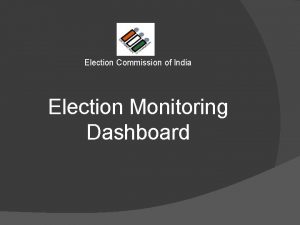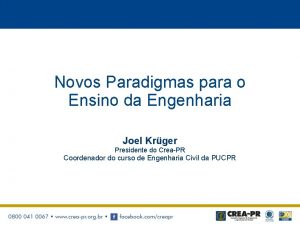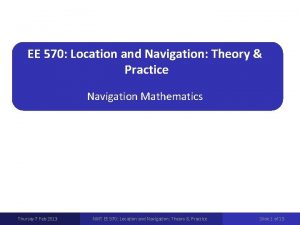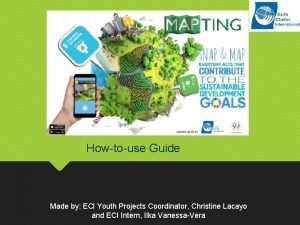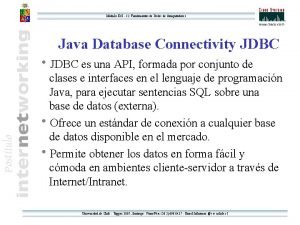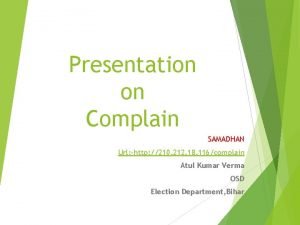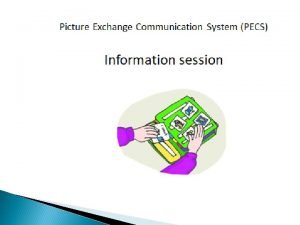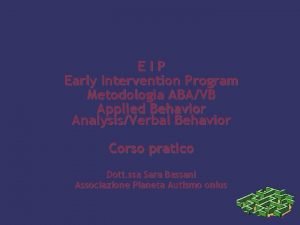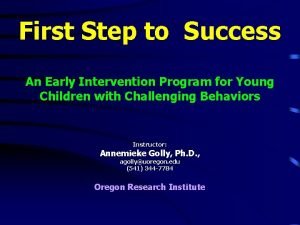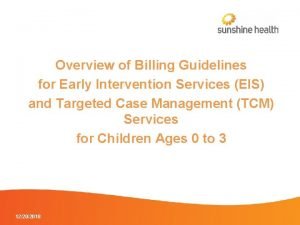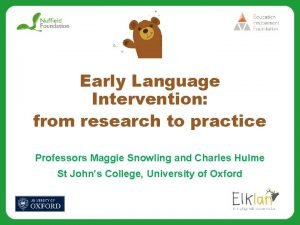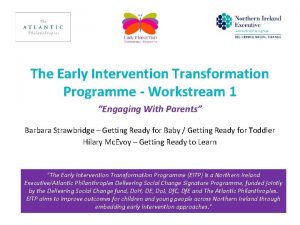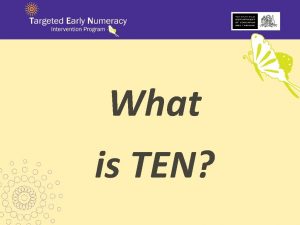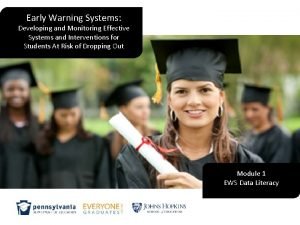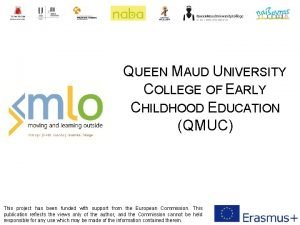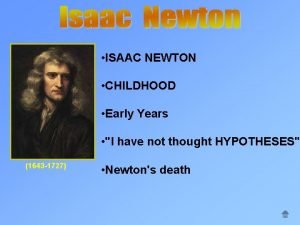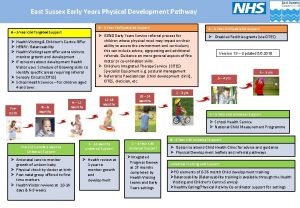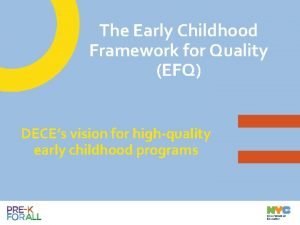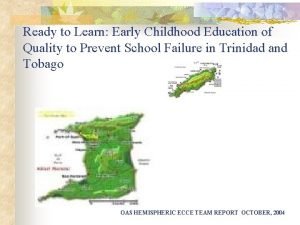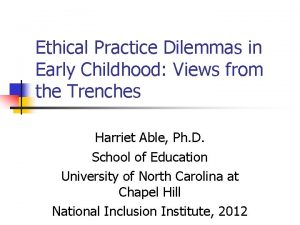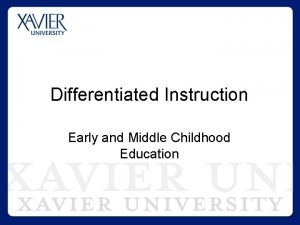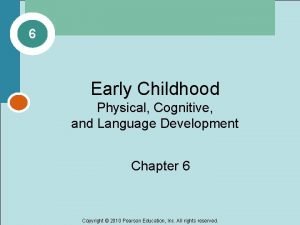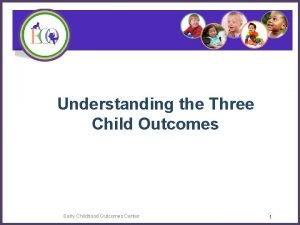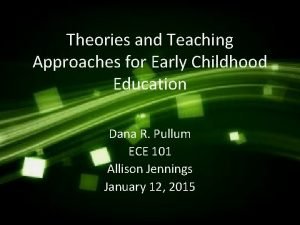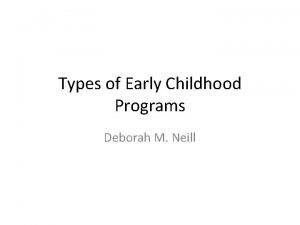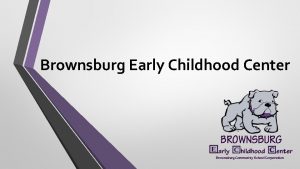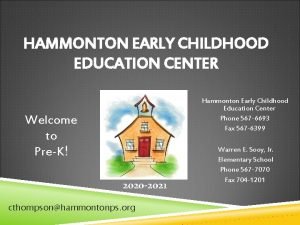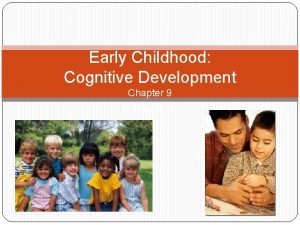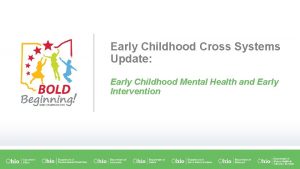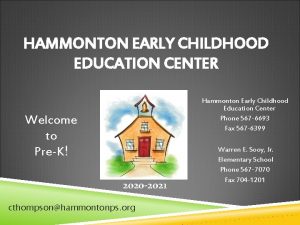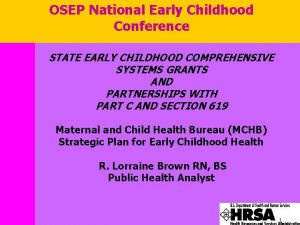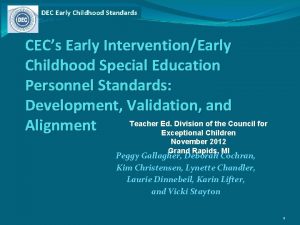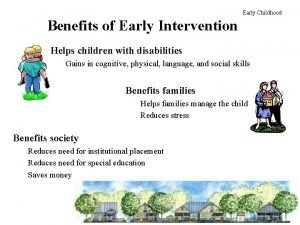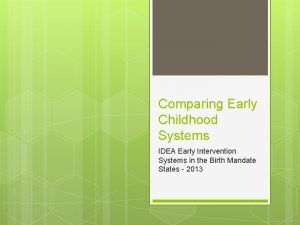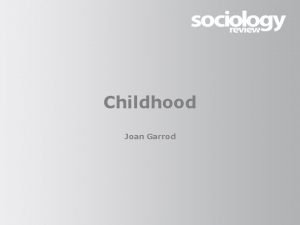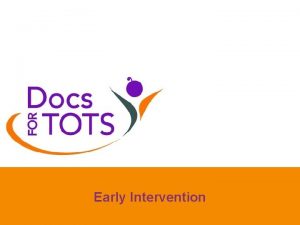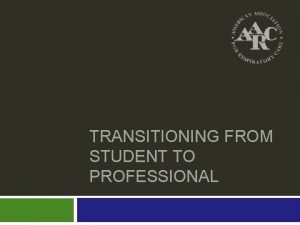Transitioning from Early Childhood Intervention ECI to Early


































- Slides: 34

Transitioning from Early Childhood Intervention (ECI) to Early Childhood Special Education (ECSE) for a Student who is Deafblind

Jennifer Magee, TDB, TDHH, Diagnostician, Katy ISD Kittrell Antalan, COMS, CTVI, Katy ISD Carolyn Samson, CTVI, COMS, Katy ISD Diana Martinez, Parent Elaine Robertson, Instructional Officer for Deaf Education, Vision, and Assistive Technology, Katy ISD

Objectives ● ● ● Role of Early Childhood Education Administrative Role Challenges Meet Oliver Programming during Early Childhood Intervention Transition to Early Childhood Special Education

Objectives ● ● ● Assessments Unique Roles of Teacher of the Deafblind Talk with Oliver’s mom, Diana Martinez Tips Resources

The Role of Early Childhood Intervention ● Early Childhood Intervention’s role in public education ● Katy Independent School District’s Early Childhood Education ● The typical Early Child Intervention, ECI (IDEA Part C) transition to Early Childhood Special Education, ECSE (IDEA Part B) ● Challenges with the transition encountered with students who are deafblind ● Participation in the TSBVI Deafblind Pilot Project ● Reasons for the selecting a student who would be transitioning from ECI to ECSE services

Administrative Role ● Acquire knowledge on the unique needs of students who are deafblind ● Provide access to trainings and experts of deafblind education for teachers of the deaf and hard of hearing, teachers of the visually impaired, and certified orientation and mobility specialists ● Provide financial and educational resources for the required training and implementation of best practices for students who are deafblind

Administrative Role ● Educate other administrators who are responsible for funding about the unique needs of students who are deafblind and role of an intervener to provide access to the environment, communication, and meaningful learning as applicable. ● Build a strong staff and support system for students who are deafblind that will sustain overtime

Challenges based on previous experience: ● New team members did not have any training in deafblind education ● Programming/goals were not appropriate for student ● Lack of mutual understanding between school staff and parents because staff did not understand the nature of deafblind students at the time. ● Team had lack of knowledge on how to provide best practices for students with deafblindness ● When student was in kindergarten, team requested an on-site consultation from TSBVI

Meet Oliver

Meet Oliver ● ● ● Oliver turned 3 last March, 2020 Meets eligibility for DB, OHI, and SI Oliver receives services for AI, VI, O&M, Speech, and AT Moderate-severe to profound sensorineural hearing loss Left cochlear implant at 15 months

Meet Oliver ● Born with cataracts in both eyes, Eye surgery on 2/16/18 ● Congenital glaucoma ● Chromosome-1 deletion ● Tube-fed ● Suspected heart murmur

Programming during ECI ● What the program look liked ○ TDHH ○ VI ○ O&M ○ Interpreter ● Team Collaboration Goals & Activities implemented ○ Reach, Grasp, Tolerance and Greetings ○ Started with visual and tactual identification/greetings

Programming during ECI ● Goals and Strategies continued… ○ Multisensory activities including temperature ○ Following his lead ○ Wait time - give more opportunity for exploring. Teachers were initiating and doing to much for Oliver. ○ Limiting activities to build in more wait time and time to explore ● New Team Members Recommendations & Strategies for Deafblind Student

Oliver Greeting

Oliver’s Third Birthday

Transition to ECSE Goals: ● TVI/TDB- Familiarize ourselves with Oliver and his family during his last year in ECI ● TVI/TDB - Provide new team members fundamental knowledge in deafblind education before they begin working and assessing the student

Transition to ECSE Goals: ● Write goals and accommodations unique to a student who is deafblind and to Oliver ● Continued collaborative team approach to instruction and communication ● Had continued support through the DB Pilot at TSBVI

Assessments Deaf and Hard of Hearing: ● Cottage Acquisition Scales for Listening, Language, and Speech: Pre-Verbal Level www. edproducts. sunshinecottage. org ● Hawaii Early Learning Profile www. vort. com ● The SKI HI Language Developmental Scale www. hopepubl. com

Assessments Deaf and Hard of Hearing: ● The INSITE Developmental Checklist www. hopepubl. com ● Informal Functional Hearing Evaluation www. pathstoliteracy. org

Assessments Vision: ● Expanded Core Curriculum Needs Screening Tool www. pathstoliteracy. org ● Oregon Project Skills Inventory www. perkinselearning. org ● Functional Scheme Assessment www. activelearningspace. org

Assessments Deaf. Blind: ● Multi-Sensory Impaired Unit Curriculum www. pathstoliteracy. org ● Communication Matrix www. communicationmatrix. org

Unique Roles and Responsibilities of the TDB ● The best practices for students who are visually impaired are not always appropriate for students who are deafblind. ● The best practices for students who are deaf or hard of hearing are not always appropriate for students who are deafblind. ● The teacher of the visually impaired relies on hearing within the normal range to teach students who are visually impaired; the teacher of deaf and hard of hearing relies on 20/20 or corrected 20/20 vision to teach students who are deaf or hard of hearing.

Unique Roles and Responsibilities of the TDB ● Students who are deafblind rely various degrees of touch, hearing, and vision for communication and learning. . The best practices for students who are deafblind are unique due the impaired combined vision and hearing losses. Only a teacher of the deafblind can provide guidance for these unique services.

Unique Roles and Responsibilities of the TDB ● Assess and evaluate using appropriate tools for students who are deafblind with a collaborative model including multiple disciplines and the parent(s) ● Know and apply the state and federal criteria for deafblind to determine eligibility ● Write the IEP paperwork based on meaningful data to support, state, and develop the strengths and needs of the student

Unique Roles and Responsibilities of the TDB ● Provide direct instruction for the students who are deafblind by addressing their needs for access to their environment, communication, and learning ● Lead, educate, support, and collaborate with the educational team ● Respect the culture and the language of the student’s family

Unique Roles and Responsibilities of the TDB ● Value the knowledge and expertise of other professionals and the parent(s) on the team ● Maintain current professional knowledge and skills through professional training, organizations, networking, and education ● Register students who are deafblind with your state Deafblind Child Count

Unique Roles and Responsibilities of the TDB ● Monitor and record the student’s progress and the effectiveness of strategies and accommodations ● Educate the administrators on the uniqueness of students who are deafblind and the best practices required to meet their needs https: //sites. google. com/tsbvi. edu/tdb-home/

Talk with Diana Martinez

Reading with Mom

Tips Working with student: ● ● ● ● Wait time Follow student’s lead Greeting/Good-bye routine Consistency Incorporate student likes and dislikes Observe student Multisensory activities

Tips for team: ● ● ● Training in deafblind education Maintain a shared folder with videos, likes/dislikes, routines, etc. Monthly team meetings Shared goals Provide combined services as the TVI, TDHH, Orientation and Mobility, the teacher, and the Speech and Language Therapist as possible and needed

References and Resources Belote, M. (2009, April 3). Touch cues. California Deafblind Services. Functional Vision: A Practitioner's Guide to Evaluation and Intervention, AFB Press Miles, B. & Mc. Letchie, B. (2008, February). Developing concepts with children who are deaf-blind. National Consortium on Deaf-Blindness

References and Resources Moss, K. (2017, June 15). Some things to learn from learning from touch. Texas School for the Blind and Visually Impaired. Sewell, D. (2008). Becoming empowered through self-determination skills. Texas School for the Blind and Visually Impaired (n. d. ). Calendar section of communication for children with deafblindness or visual impairments. Texas School for the Blind and Visually Impaired. https: //www. tsbvi. edu/distance/communication/calendars

References and Resources Texas School for the Blind and Visually Impaired (n. d. ). Teachers of students who are deafblind in texas: unique roles and responsibilities of the tdb. Texas School for the Blind and Visually Impaired. https: //www. tsbvi. edu/tdb-home/
 Middle childhood and adolescence
Middle childhood and adolescence Eci dashboard
Eci dashboard Eci mac
Eci mac Eci ecef
Eci ecef Eci company
Eci company Eci principles
Eci principles Eci 11
Eci 11 Samadhan eci
Samadhan eci What is pec’s?
What is pec’s? Haw creek elementary
Haw creek elementary First step early intervention
First step early intervention Po box 3070 farmington mo 63640
Po box 3070 farmington mo 63640 Nuffield early language intervention programme
Nuffield early language intervention programme Early intervention transformation programme
Early intervention transformation programme Targeted early numeracy intervention program
Targeted early numeracy intervention program Early warning intervention and monitoring system
Early warning intervention and monitoring system Early childhood center flushing mi
Early childhood center flushing mi Early childhood education
Early childhood education What is biosocial development in early childhood
What is biosocial development in early childhood Isaac newton early life and education
Isaac newton early life and education Physical development in early childhood
Physical development in early childhood Emily dickinson adulthood
Emily dickinson adulthood Early childhood framework for quality
Early childhood framework for quality Swot analysis early childhood education
Swot analysis early childhood education Ethical dilemmas in early childhood education
Ethical dilemmas in early childhood education Ldoe delivery recipes
Ldoe delivery recipes Early childhood education in bangladesh
Early childhood education in bangladesh Language development in early childhood
Language development in early childhood Early childhood outcomes center
Early childhood outcomes center Leonardo da vinci early childhood
Leonardo da vinci early childhood Skinner's operant learning theory
Skinner's operant learning theory Types of early childhood programs
Types of early childhood programs Kentucky governor's office of early childhood
Kentucky governor's office of early childhood Brownsburg early childhood center
Brownsburg early childhood center Eminem early childhood
Eminem early childhood

